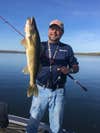10 Reasons You’re Not Catching Walleyes
The top 10 blunders we make on the water-and how to avoid them.

Gary Parsons, a professional tournament angler from Glidden, Wisconsin, recalls trolling on Lake Erie with an amateur partner who grabbed the rod, set the hook, and began reeling in furiously at the first fish on. The huge walleye rolled on the surface, ripping the crankbait free.
Too late, Parsons explained that there is no need to set the hook while trolling and that controlled pressure is the best way to get a walleye to boat. The lost fish meant thousands of dollars from their winnings.
Parsons and Mark Martin, a tournament pro from Twin Lake, Michigan, have seen walleye anglers make lots of mistakes, so they produced this list of the most common blunders—and how to fix them. Read carefully, and mend your ways.

1. Your bait isn’t fresh enough.
Most anglers don’t realize the natural movement of live bait is more important than scent or taste. To ensure crawlers and leeches continue undulating, change your bait every five to 10 minutes. Minnows last longer, but still check them regularly.
2. Your jigs are too heavy.
“Use the lightest jig possible,” says Parsons. “Heavy jigs make it harder to feel strikes, which are usually just a subtle resistance. My bread-and-butter jigs weigh 1/16 and 1/8 ounce. I go to a 1/4-ounce jig in windy conditions. Strong river currents may dictate a 3/8-ounce or 1/2-ounce jig, but I still go as light as I can.”
3. Your jigs and rigs are dragging on the bottom.
“The more you drag, the more you snag,” says Martin. “Your jigs, live-bait rigs, and bottom bouncers should swim just above the bottom most of the time, with occasional bottom contact only. Then, when you feel a tick, chances are it’s a fish. Set the hook.”
4. You’re casting too far.
Long casts lead to more snags and detecting fewer bites, especially when fishing jigs. Position your boat so you can make short casts—say, 30 feet or so—which give the jig a nice pendulum fall and reduce the wind’s influence on the line.
5. You’re cranking weed edges too slowly.
Walleyes relating to weedbeds often school tightly. To find them, quickly work a crankbait along the edges until you get a strike. You can pick that area apart slowly after you find the fish with a fast-moving lure. A lipless rattling crankbait helps you cover water near the surface quickly. Deeper fish call for a diving crankbait with a pronounced action.
6. You’re letting out too much line when trolling.
Balance trolling speed with a bottom-bouncer weight to keep your line at a 45-degree angle. Too much line will make the bottom-bouncer fall over, dragging the trailing bait or spinner rig instead of letting it swim along enticingly.
7. You’re trolling too fast.
A slow pace of 1 to 2 miles per hour is ideal, regardless of the season. Within this range, even a difference of .1 mph can be crucial. Determine the most productive trolling speed and maintain it, using a trolling-speed indicator or the speed-over-ground readout on a GPS.
8. You’re neglecting your electronics.
Buy the best, highest-resolution electronics you can afford, and turn up the sensitivity. Don’t waste time in places where it doesn’t indicate fish. Some units show the bottom, fish, and baitfish in different colors. This is especially helpful with bottom-hugging walleyes.
9. You’re leaving fish behind.
When you get several bites while trolling, instead of continuing in your planned run, return to the productive stretch before the walleyes move or stop feeding. This is especially useful for suspended fish in open water. If you can, use a GPS to accurately troll the sweet spot from the same angle.
10. You’re pumping the rod.
Don’t pump the rod or set the hook while trolling. (The boat’s movement will take care of this). Hold the rod still and crank steadily, stopping when the fish lunges or shakes its head. Keep the drag loose and the rod tip low over the side to prevent the fish from surfacing and throwing the hook.


